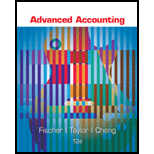
Advanced Accounting
12th Edition
ISBN: 9781305084858
Author: Paul M. Fischer, William J. Tayler, Rita H. Cheng
Publisher: Cengage Learning
expand_more
expand_more
format_list_bulleted
Question
Chapter 11, Problem 1UTI
To determine
Concept Introduction:
The functional currency refers to the currency of that country in which entity generates cashflows and spend cash to make purchases.
To indicate:The factors that reflects that the domestic currency of the foreign company is not a functional currency.
Expert Solution & Answer
Explanation of Solution
The entity’s domestic currency is not always considered as functional currency. For instance, if the company in X country borrows funds from the bank of Y country than the currency of Y country is functional currency rather than the currency used in country X.
Some of the major factors which reflects that the currency is not a functional currency are as follows:
- Cashflows: If cashflows are generated in other country. For instance, the Country X operates in country Y, then the currency of Country Y will be considered as functional currency.
- Financing: Funds procured from other country in their currency.
- Sales market: If goods and services are sold in other country at their currency.
- Expenses: If goods and services are purchased from other country. For instance, if country X’s domestic currency is dollar and the goods and services bought from country Y is in Yen, then Yen will be the functional currency.
Want to see more full solutions like this?
Subscribe now to access step-by-step solutions to millions of textbook problems written by subject matter experts!
Students have asked these similar questions
what are implications for analysis of financial statements that result from the accounting for foreign currency translation?
Which of the following items will result to foreign currency transaction gain/loss due to settlement or remeasurement?
Foreign currency denominated non-monetary liabilities such as unearned revenue, warranty liability, premium liability and deferred tax liability.
Foreign currency denominated non-monetary assets such as inventory, PPE, intangible asset or prepaid asset.
Foreign currency denominated monetary items such as accounts payable, accounts receivable, notes payable, loans receivable or interest payable.
Foreign currency denominated income statement accounts such as revenue, income, expense or loss.
which shall be recognized for each item when foreign currency gain or loss that arises from translation of foreign currency denominated transaction to functional currency?
a. inventiry
b. interest expense
c. accounts receivable
d. unearned revenue
Knowledge Booster
Similar questions
- Foreign exchange risk arises when: A)business transactions are denominated in foreign currencies. B)sales are made to customers in a foreign country. C)goods or services are purchased from suppliers in a foreign country. D)accounting reports are prepared in a foreign currency.arrow_forwardBriefly summarize the accounting issues arising from foreign currency denominated transactionsarrow_forwardWhat are the consequences of accounting for foreign currency translation on financial statement analysis?arrow_forward
- Which of the following suggests that the foreign entity's functional currency is the parent's currency? a. Intercompany transaction volume is low. b. Debt is serviced through local operations. c. There is an active and primarily local market. d. Sale prices are influenced by international factors.arrow_forwardExplain the rule for translating the Financial Statements of Foreign Operations from Functional Currency to Presentation Currency.arrow_forwardIf the functional currency is determined to not be the foreign entity's local currency, translation is done using a. the current rate method b. the functional method c. the remeasurement method d. the derivative methodarrow_forward
- 1. Which of the following statements is incorrect? * A. A foreign operation (e.g., a branch) that is essentially an extension of the entity (e.g., the home office) would have the same functional currency as that of the entity. B. An entity can only have one functional currency but it can have as many presentation currencies as it wishes. C. Subsequent to initial recognition, both monetary and non-monetary items arising from a foreign currency transaction are translated at the closing rate. D. A foreign currency transaction is initially recognized at the spot exchange rate at the date of the transaction. 2. According to PAS 21, exchange differences arising from the translation of monetary items arising from foreign currency transactions are recognized in * A. Directly in equity B. Any of these C. Other comprehensive income D. Profit or lossarrow_forwardF. Accountingarrow_forwardClarke Company has a subsidiary operating in a foreign country. In relation to this subsidiary, what does the term functional currency mean? How is the functional currency determined?arrow_forward
- The effects of changes in foreign exchange rates states that where an entity has foreign operations, such as overseas subsidiaries, branches, joint ventures or associates, it should determine the functional currency of that foreign operation. MFRS 121 The Effects of Changes in Foreign Exchange Rates deals with this issue. Required:Explain the factors which should be taken into consideration in determining whether or not the functional currency of a foreign operation is the same as that of its parent.arrow_forwardExplain why the following statement is true or false: “Direct intervention for currency valuation involves limiting the ability to exchange domestic currency for foreign currency.”arrow_forwardWhat are the difficulties or dangers inherent in analyzing foreign financial statements? Consider the following instances.arrow_forward
arrow_back_ios
SEE MORE QUESTIONS
arrow_forward_ios
Recommended textbooks for you
 Intermediate Financial Management (MindTap Course...FinanceISBN:9781337395083Author:Eugene F. Brigham, Phillip R. DavesPublisher:Cengage Learning
Intermediate Financial Management (MindTap Course...FinanceISBN:9781337395083Author:Eugene F. Brigham, Phillip R. DavesPublisher:Cengage Learning Financial Reporting, Financial Statement Analysis...FinanceISBN:9781285190907Author:James M. Wahlen, Stephen P. Baginski, Mark BradshawPublisher:Cengage Learning
Financial Reporting, Financial Statement Analysis...FinanceISBN:9781285190907Author:James M. Wahlen, Stephen P. Baginski, Mark BradshawPublisher:Cengage Learning


Intermediate Financial Management (MindTap Course...
Finance
ISBN:9781337395083
Author:Eugene F. Brigham, Phillip R. Daves
Publisher:Cengage Learning

Financial Reporting, Financial Statement Analysis...
Finance
ISBN:9781285190907
Author:James M. Wahlen, Stephen P. Baginski, Mark Bradshaw
Publisher:Cengage Learning